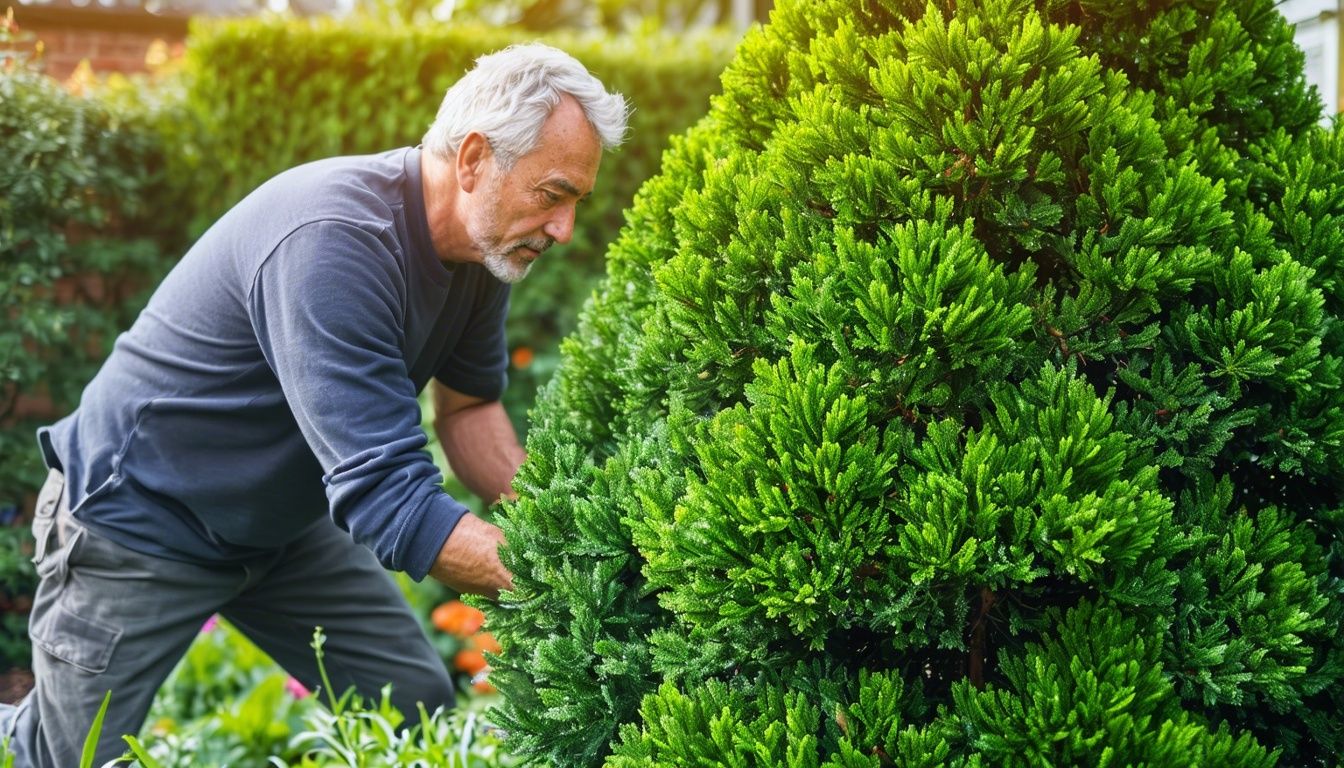How to Care for Thuja Green Giant Shrubs (2024)
Do you have Thuja Green Giant shrubs that aren’t thriving as expected? Maybe they’ve become a bit scraggly, or you’re unsure how to water and fertilize them properly. If this sounds familiar, you’re not alone.
Did you know that once their roots are well-established, Thuja Green Giant require minimal maintenance? This fact makes them an excellent choice for busy gardeners.
Our comprehensive guide will show you the best ways to care for your Thuja Green Giant shrubs. From planting techniques to seasonal care tips, we’ve got everything covered. Keep reading to transform your shrubs into lush greenery!
Optimal Planting Techniques for Thuja Green Giant

Pick a sunny spot with well-drained soil. Dig holes deep enough to cover the shrub’s root ball but not too deep.
Choosing the Right Location for Thuja Green Giant
Thuja green giant evergreen trees thrive in growing zones 5 through 9. These evergreen shrubs can handle temperatures as low as -20°F. Planting them in spring or fall helps their roots establish better.
This allows for strong growth and less maintenance later on.
Ensure the area has good drainage to prevent root rot. Avoid planting too close to fences or structures, as these trees grow fast and need space. Proper spacing not only aids healthy growth but also makes a great privacy screen quickly.
Soil Preparation for Thuja Green Giant Tree
Loosen the soil to a depth of about 12 inches. Mix in organic matter like compost or peat moss to improve drainage and nutrient content. This creates a welcoming environment for root growth, especially important in zones where cold winters prevail.
Ensure the soil is well-draining but retains some moisture. Avoid areas prone to standing water as thuja green giants dislike wet feet. For best results, plant these shrubs in spring or fall during milder temperatures.
Gardening expert John Smith advises that preparing the right soil mix sets your Thuja Green Giant up for success.
Planting Depth and Spacing Trees For Privacy
Dig a hole as deep as the root ball and twice its width. Place each Thuja Green Giant shrub 5 to 6 feet apart. This allows room for growth and ensures proper air circulation.
Backfill the hole with well-draining soil, making sure there are no air pockets. Firmly press down but avoid compacting the soil too much. This helps establish strong roots in zones 5 through 9, where these cold-hardy trees thrive down to -20°F.
Light Requirements for Healthy Growth
Thuja Green Giant shrubs need plenty of sunlight to thrive. Make sure they receive at least six hours of direct light each day.
Ideal Sun Exposure for Green Giant Arborvitae Care
Green Giants thrive in full sun. They need at least 6 hours of sunlight each day. This exposure helps them grow tall and strong. Planting them in a spot that gets morning sunlight is ideal.
If your yard has areas with partial shade, don’t worry too much. thuja green giant evergreen trees are adaptable and can handle some shade. Just ensure they receive plenty of light overall to support their fast growth rate.
Sunlight is the best medicine for thuja green giant evergreen tree, says gardening expert Jane Doe.
Adjusting Shade To Create A Privacy Screen
Thuja Green Giants thrive with full sun exposure. They do best in areas that receive at least 6 hours of direct sunlight daily. If planted in shade, they may grow slower or develop sparse foliage.
To help them adjust to more shaded spots, trim nearby branches or remove obstacles that block light.
Planting Thuja Green Giants too close together can also create unwanted shade. Ensure proper spacing by keeping at least 5-6 feet apart from each other and structures like fences. This spacing allows adequate air circulation and light penetration for healthy growth.
Next up, let’s explore the best watering techniques for your Thuja Green Giant!
Watering Your Thuja Green Giant
Water your Thuja Green Giant deeply once a week. Ensure the soil remains consistently moist but not waterlogged.
Watering Frequency For Thuja Trees
Thuja Green Giants need watering every other day during their first month after planting. This helps establish strong roots. After the first month, water them once a week if there is no rain.
Each evergreen tree needs about an inch of water per week.
Signs of overwatering include yellowing leaves and root rot. If the plant looks wilted or brown, it might not be getting enough water. Adjust your watering schedule based on these signs and season changes to keep your shrubs healthy and thriving all year round.
Signs of Over and Underwatering
Proper watering is critical for the health of Thuja Green Giant shrubs. Monitor your plants carefully to keep them thriving.
- Yellowing Leaves
Yellow or pale leaves can indicate overwatering. Too much water drowns the roots and blocks oxygen.
- Wilting
Both over-watered and under-watered plants may wilt. Check the soil moisture to determine the cause.
- Brown Leaf Tips
Brown tips often mean underwatering. Dry soil stresses the plant, leading to dry leaves.
- Moldy Soil Surface
Mold growing on top of the soil is a sign of excess moisture and poor drainage.
- Root Rot Signs
Foul smell from the soil or mushy roots indicates root rot, common with overwatering.
- Slow Growth
Stunted growth might be due to underwatering, as roots can’t access enough nutrients without water.
- Drooping Branches
Branches droop when they get too much water because heavy, waterlogged soil can’t support healthy roots.
- Crispy Leaves
Crispy, dry leaves signal a lack of water, especially in hot weather.
Ensure consistent watering practices for robust Thuja Green Giants.
Nutritional Needs and Fertilizing For Thuja Green Giant Arborvitae
Use a balanced fertilizer to keep your Thuja Green Giant healthy. Apply the fertilizer in early spring for best results.
Recommended Fertilizers For Privacy Tree
Thuja Green Giants thrive with the right fertilizers. Use a balanced fertilizer, such as a 10-10-10 mix, in their second year. Fertilize once in early spring and again midsummer. Avoid fertilizing within the first year to allow roots to establish well.
Organic options like compost or aged manure are excellent choices too. Spread a thin layer around the base of each shrub but keep it away from the trunk. Pair this with consistent watering for optimal growth and health of your Thuja Green Giant shrubs.
Next up: Timing and Frequency of Application
Timing and Frequency of Application
Apply fertilizer to your Thuja Green Giant in the spring. This helps boost new growth as the weather warms up. Use a well-balanced, slow-release fertilizer specifically for evergreen trees.
Do not fertilize your shrubs during their first year in your yard. They need time to establish strong roots first. Once they are established, fertilize them once each year for best results.
Best Practices for Pruning comes next!
Pruning and Maintenance Privacy Screen
Trim your Thuja Green Giant annually to maintain its shape. Remove dead or damaged branches to encourage healthy growth.
Best Pruning Practices for Trees for Privacy
Pruning Thuja Green Giant shrubs helps maintain their shape and encourages healthy growth. Proper techniques ensure the shrubs remain attractive and strong.
- Use Sharp Pruners
Always use sharp pruners to make clean cuts. This helps avoid damage and reduces the risk of disease.
- Prune in Spring
Late winter or early spring is the best time for pruning. This timing promotes new growth as the shrub enters its growing season.
- Remove Dead Branches First
Cut off any dead or damaged branches first. This allows the plant to channel energy into healthy parts.
- Cut Above a Growth Point
Make cuts just above a growth point or bud. This encourages bushier growth and prevents unsightly stubs.
- Thin Out Dense Areas
Remove branches from crowded areas to improve airflow and light penetration. This keeps the shrub healthy and less prone to disease.
- Avoid Over-Pruning
Do not remove more than one-third of the shrub at a time. Over-pruning can stress the plant and hinder its growth.
- Shape Gradually
Shape your Thuja Green Giant gradually over several seasons. Drastic changes in one go can harm the plant’s health.
- Keep Bottom Wider Than Top
Prune so that the base is wider than the top to allow sunlight to reach all parts of the shrub evenly.
- Disinfect Tools Between Cuts
Disinfect your pruning tools between cuts, especially if you notice any diseased branches, to prevent spreading pathogens.
- Mulch After Pruning
Apply mulch around the base after pruning to retain moisture and regulate soil temperature, which supports recovery.
- Monitor New Growth
Watch for new shoots after pruning and trim as necessary to maintain desired shape and structure throughout the season.
Regular pruning keeps thuja green giant looking their best while promoting robust health and preventing common problems like crowded branches or poor air circulation.
Seasonal Maintenance Tips For Evergreen Trees
Pruning is crucial for maintaining the shape and health of your Thuja Green Giant. Equally essential are the seasonal maintenance tips to ensure they thrive.
- Spring Care Tips
- Clear away any winter debris around the shrubs.
- Check for any signs of disease or pests early in the season.
- Apply a balanced slow-release fertilizer after new growth appears.
- Summer Care Tips
- Water deeply once a week during hot, dry periods.
- Inspect foliage regularly for signs of stress or mildew.
- Mulch around the base to conserve moisture and regulate soil temperature.
- Fall Care Tips
- Prune to remove dead or damaged branches before dormancy sets in.
- Apply mulch to protect roots from freezing temperatures.
- Reduce watering as temperatures drop, but ensure soil remains moist.
- Winter Care Tips
- Protect young shrubs with burlap wraps if heavy snow or ice is expected.
- Ensure proper drainage to prevent root rot from excessive rain or melted snow.
- Brush off heavy snow from branches gently to avoid breakage.
Protecting from Pests and Diseases For Evergreen Tree
Check your Thuja Green Giant shrubs regularly for signs of pests. Use appropriate treatments to keep them healthy and strong.
Common Pests For Thuja Arborvitae
Bagworms are a common nuisance for Thuja Green Giants. These pests create silky bags that hang from branches and devour the tree’s foliage. A heavy infestation can even kill young trees.
Regularly inspect your shrubs, especially in late spring, for these small, cone-shaped bags.
Spider mites are another problem you might face with Thuja Green Giants. They suck sap from the leaves, causing them to turn yellow or brown and drop off. To spot them early, check under leaves for tiny webs or specks.
If found, use insecticidal soap to control their spread before significant damage occurs.
Disease Prevention Strategies For Thuja Green Giant Care
Check your thuja green giant regularly for any signs of disease. Look out for discoloration or unusual spots on the leaves. Watering your shrubs at their base helps keep foliage dry and reduces the risk of fungal infections.
Good air circulation also prevents disease, so avoid overcrowding by ensuring proper spacing between plants.
Fertilize with care to avoid overfeeding, which can weaken plants and make them more susceptible to diseases. Remove any dead or diseased branches promptly to stop the spread of infection.
Keep an eye out for common pests like aphids and caterpillars that can carry diseases into your garden area.
Seasonal Care For Thuja Guide
Tend to your shrubs differently based on the time of year. Each season requires specific steps for optimal growth and health.
Spring Green Giant Care Tips
Spring is the perfect time to plant Thuja Green Giants. Choose a spot with full sun to partial shade and well-draining soil. Ensure the space allows for 5-6 feet of growth between each shrub for optimal root expansion.
This helps prevent crowding and promotes healthy development.
Water newly planted shrubs thoroughly, then continue watering regularly until they are well-established. Avoid fertilizing in their first year; this gives roots a chance to set firmly without stress from nutrients.
Apply mulch around the base to retain moisture and suppress weeds, aiding robust growth as temperatures rise into summer care tips.
Summer Care For Thuja
As the temperatures rise, water your Thuja Green Giants more frequently. Deep watering once a week helps their roots grow strong. Check the soil daily for dryness, especially during heatwaves.
Install mulch around the base of your shrubs to keep moisture in and weeds out. Mulching also prevents soil erosion and keeps roots cool. Ensure good air circulation by spacing plants properly to avoid fungus growth in humid weather.
Fall Care Tips For Caring For Thuja Green Giant
Adjust your watering schedule, thuja green giant tree needs less water in the fall because the temperatures drop and there’s more natural rainfall. Water them deeply once a week if it hasn’t rained.
Inspect for pests and diseases. Fall is a good time to check your shrubs for any signs of trouble like browning leaves or unusual spots. Treat early to prevent bigger issues next spring.
Add mulch around the base. A 2-3 inch layer of mulch helps protect roots from cold snaps and retains soil moisture.
Prune lightly if needed. Cutting back dead or broken branches keeps your shrubs healthy through winter.
Next, we’ll cover tips for caring for thuja green giant trees during winter months.
Winter Care For Thuja
Protect thuja green giant from heavy snowfall by gently brushing off excess snow. This prevents branches from breaking under the weight. Mulch around the base with a thick layer of organic material to insulate roots against extreme cold.
Ensure proper watering before the ground freezes. Well-hydrated evergreen trees can better withstand winter stress. Cover young plants with burlap or frost blankets in extremely low temperatures, especially below -20°F.
Keep an eye out for any signs of damage to maintain healthy growth into spring.
Enhancing Growth and Appearance
Enhancing Growth and Appearance Emerald Green Arborvitae
Adding mulch around the base helps retain moisture and suppress weeds. Trim regularly to maintain a neat, compact shape.
Mulching Techniques
Mulch helps keep the soil moist and the roots cool for Thuja Green Giants. Spread a layer of mulch, about 2-3 inches thick, around the base of each shrub. Use organic materials like wood chips, bark, or compost.
Keep the mulch away from the trunk to prevent rot and pests. This technique also suppresses weeds and enhances soil health. Check and refresh your mulch annually to maintain its benefits.
Techniques for Encouraging Dense Growth
Proper mulching sets the stage for dense growth. Pair this with regular pruning to shape your Thuja Green Giant and promote multiple branches. Prune in early spring before new growth starts.
Clip off dead, damaged, or overgrown branches using clean, sharp tools.
Provide ample water during dry periods, especially in the first year. Feed your shrubs with a balanced fertilizer once established but not within their first year of planting. Apply mulch around the base to retain moisture and keep roots cool.
This helps create lush, green foliage that fills out beautifully.
Leyland Cypress vs. Thuja Green Giant: Detailed Comparison
Thuja Green Giant and Leyland Cypress are both popular choices for privacy screen and landscaping. Here’s a detailed comparison to help you choose the best fit for your garden:
|
Feature |
Thuja Green Giant |
Leyland Cypress |
|---|---|---|
|
Growth Rate |
Fast-growing, up to 3-5 feet per year |
Very fast-growing, up to 3-4 feet per year |
|
Height |
50-60 feet at maturity |
60-70 feet at maturity |
|
Width |
12-20 feet |
15-25 feet |
|
USDA Zones |
Zones 5-9 |
Zones 6-10 |
|
Cold Hardiness |
Down to -20°F |
Down to -10°F |
|
Maintenance |
Low maintenance once established |
Requires regular pruning |
|
Soil Requirements |
Well-drained, fertile soil |
Adaptable but prefers well-drained soil |
|
Disease Resistance |
Resistant to most diseases |
Susceptible to canker and root rot |
|
Pest Resistance |
Generally pest-resistant |
Vulnerable to spider mites and aphids |
|
Water Needs |
Moderate; drought-tolerant once established |
Moderate; needs consistent moisture |
|
Light Requirements |
Full sun to partial shade |
Full sun to partial shade |
Both trees can provide fast-growing privacy screen screens, but Thuja Green Giant has the edge in cold hardiness and disease resistance.
Troubleshooting Common Issues of Thuja Green Giant Arborvitae
Look for yellowing or browning leaves, which could signal problems. Check the soil and watering schedule to ensure healthy growth.
Addressing Browning Leaves For Caring For Thuja Green Giant
Browning leaves on your Thuja Green Giant can indicate stress. Common causes include improper watering, pest infestations, or poor soil conditions. Ensure that the soil is well-draining and water the shrubs consistently, but not excessively.
Inspect for pests such as bagworms and spider mites. Use appropriate treatments to handle infestations. If browning persists despite proper care for your Thuja green giant shrub, consider consulting a local garden expert for further diagnosis.
Managing Slow Growth Emerald Green Arborvitae
Slow growth in Thuja Green Giants can be frustrating. Start by checking the soil quality. Well-draining soil is essential for healthy growth. Poorly draining soil can stunt root development.
Ensure your shrubs have plenty of space; crowded plants compete for nutrients, affecting growth rates.
Fertilizing too early can harm young plants. Avoid fertilizing within their first year and opt for a balanced fertilizer afterward. Make sure they receive enough sunlight as well since shaded areas slow down their rapid growth rate known to thrive best in zones 5 through 9 and are cold hardy down to -20°F. If you’re looking to add these shrubs to your landscape, they can be conveniently purchased from Privacy Shrubs.
Conclusion
Thuja green giant thrive when planted correctly. Choose the right location with ample sunlight and well-draining soil. Water them regularly, but avoid overwatering. Use recommended fertilizers at the proper times.
Pruning keeps these shrubs healthy and attractive. Protect them from pests and diseases for lasting growth. If you want to create a privacy screen buy green giant arborvitae.
FAQs
1. How often should I water Thuja Green Giant shrubs?
Water your Thuja Green Giant shrubs once a week, especially during dry periods.
2. Do Thuja Green Giant shrubs need fertilizer?
Yes, you should fertilize them in the spring to help them grow strong and healthy.
3. How much sunlight do Thuja Green Giant shrubs need?
Thuja Green Giant shrubs need full sun to partial shade for best growth.
4. When is the best time to prune Thuja Green Giant shrubs?
The best time to prune is late winter or early spring before new growth starts.
5. Can I plant thuja green giant close together for a hedge?
Yes, you can plant them about 5-6 feet apart if you want to create a dense hedge.







